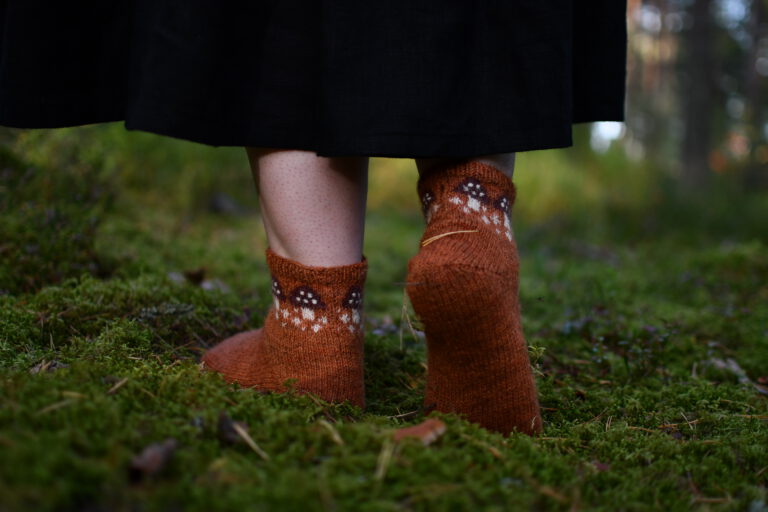Socks are a great project for knitters of all skill levels. They make thoughtful, personal gifts for just about anyone. Whether you’re crafting for yourself or for loved ones, you can never have too many pairs of cozy, handmade socks. One of the best things about making socks is that they only need a small amount of yarn to make. This is perfect for using up leftover skeins or experimenting with new colorways. There are many options for colors, patterns, and textures, making them a versatile canvas for creativity. In this post we will take a detailed look at how to make a sock, common sock styles, what the best yarn is to use, and some great sock knitting patterns.
Parts of a Sock
Socks come in a variety of shapes and styles, each designed for different purposes and preferences. Many socks share similar features, but not all sock patterns will include every possible component. In the following section, I’ll go over some of the most common parts of a sock that may or may not be present in the sock project that you are working on.
Cuff – This is the part of the sock at the very top around your leg. The cuff is a ribbed edge along the sock to make sure it stays snug against your leg. However, not all socks have cuffs. This will usually depend on the design
Leg – This is the part along the length of your calf. Depending on how long you would like your sock to be this could be very short or almost non-existent if you are going for ankle socks.
Heel – The heel, or heel flap is down along the bottom of the leg. It is often knit up in a strong, thick stitch because the heel of a sock tends to get the most wear, and can get holes easily.
Heel turn – This is the part of the sock where the direction of the sock changes. One part going up towards your leg, and at a right angle the other part needs to be going towards your toes.
Gusset – Once the direction changes over the heel, there are more stitches in that area to accommodate the widest part of the foot. The gusset helps to bridge the gap between that and the narrow length of the foot.
Foot – This is likely the most straightforward part of a sock. You simply knit for the length of the foot.
Toe – The toe is at the other end of the sock, and it usually narrows to account for the pointy shape of our toes. It also has to be closed up, to cover our toes.
How to Approach a Sock
There are two approaches to knitting a sock, top-down and toe-up. In the top-down method, you start at the cuff of the sock, then work the leg, create the heel flap and turn the heel, work the gusset, make the length of the foot, and finally shape the toe and close up the end of the sock. For the toe-up method, you start with casting on at the toe, the work the foot, then the heel, make the leg of the sock and finish with the cuff.
Designers will have their reasons for choosing one approach over the other. Some designs will be dependent on the approach you choose, while others could be knit using either approach. Some designers even provide their patterns with instructions for both toe-up and top-down knitting, leaving it up to the preference of the maker.
Pattern Styles
There are so many aspects to play with when making socks. These include color, texture and length. Each of these elements allows for endless combinations, which is one of the many reasons socks are such a popular choice for a project.
People tend to like having a bit of fun with their socks. So using bright colors is often a go-to choice. Adding accent colors on the cuff, heel and toe is also a classic way to add a little something extra to your sock. Another way of incorporating color is through colorwork designs. Even if you find colorwork a bit intimidating, doing a design along the leg of a sock can be a great way to break into this technique.
Using textured stitches in socks is a great way to add a bit of design, as well as function to your sock. Adding cabled designs can make for an extra warm and cozy sock for the winter, while using lace techniques can make for lighter, more breathable socks in warmer weather. Not to mention there are an endless number of cables and lace designs, so you’ll never get bored adding texture to your socks.
The length of socks is often a matter of the preference of the wearer. Some prefer ankle socks, others the standard mid-calf. You can even make knee-high socks and beyond if you have the motivation for it. Luckily this is easy to modify by shortening or extending the length of the leg of the sock. However, some designs might be more suited to different lengths. For example, you can make a lovely lace ankle sock, but for a colorwork leg, you will have to add a bit of extra real estate to fit in the designs.
Best Yarn for Socks
Socks are such a common type of project that many yarn brands sell a type of yarn called sock yarn. The weight might vary from brand to brand, but typically sock yarn will be about fingering weight (100g = 400m). Fingering weight is a good choice for socks because it is on the finer side. This means that it will be comfortable to wear inside a pair of shoes. However, it is not necessary to use fingering weight yarn. If you want a thicker cozier pair of socks, you might choose a thicker yarn weight. This could be ideal for house socks, or for socks that you plan to wear inside a big pair of boots. You might also want to make a finer sock for wearing with flats or mary-janes. In that case, you might choose to use a lace weight yarn for a daintier look.
The fibre content of sock yarn also varies, but it typically contains mostly merino wool with some nylon. The reason nylon is often included in the fibre blend is that it adds strength to the yarn. This is essential for socks, as they are a workhorse garment that we stuff into shoes and walk on all day. The extra support from nylon helps the fibre last longer under daily wear and tear. Cotton is another popular fibre for socks. It can be cooler to wear in the warmer months, and it is also a fairly strong fibre.
Sock Knitting Patterns
To inspire your sock knitting journey, here are some great patterns you can explore. There are some great free patterns available online. We also have many great sock patterns with various designs available in the Pattern Library in the Knit&Note app.
Free
A basic sock knitting pattern that is free and fun to knit is Hermione’s Everyday Socks. This was one of the first sock patterns that I made. This pattern uses a top-down approach. It has a very simple textured pattern throughout the sock. It looks great in both solid colors, or more exciting hand painted colorways.
Another great free sock pattern to help you learn the basics is the Rye Sock. Using a top-down construction, this sock also features a simple variation in stitches to give it an interesting look, without being too complicated. This pattern is also available for thicker yarn weights.
Rib
Ruke Socks
This pattern makes a classic, mid-calf ribbed sock that hugs your feet snugly. It’s perfect for a cozy pair to wear in colder weather, especially since it recommends using a thicker yarn, ensuring your feet stay warm and toasty throughout the day.
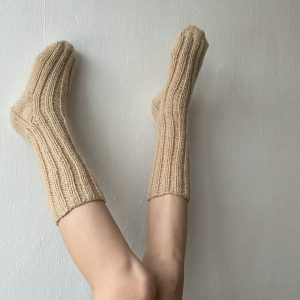
Pearl Socks
These cute but simple socks are knit up in a DK weight yarn with a broken rib design that adds a subtle texture. The pattern offers flexibility with options for both toe-up or top-down methods. They make for the perfect pair of comfy socks to wear around the house on a chilly day.
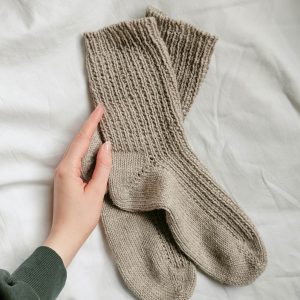
Colorwork
Mushroom Socks
Who could resist this adorable design? This pattern invites you to play with fun colorwork along the leg, allowing for a whimsical touch to your socks. After finishing the detailed colorwork section, you can relax with simple, single-color knitting for the rest of the sock.

Rhubarb and Custard Socks
These socks are a lovely example of two-stranded colorwork. By using a single color for the cuff, heel, and toe, the intricate design along the leg allows the design to stand out even more. The pattern suggests using fingering weight yarn, making them a comfortable choice for everyday wear.
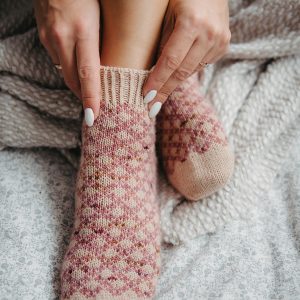
Cable & Texture
Honey Socks
These cozy socks use the toe-up method and feature a beautiful honeycomb design that runs along the top of the foot, adding texture and interest. They call for DK weight yarn, making them an excellent choice if you’re looking for a thicker, warmer pair of socks for colder days.
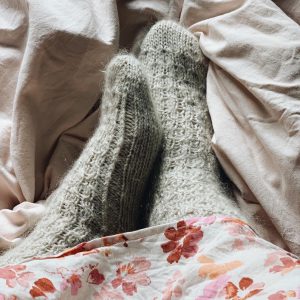
Kornblomstokker
This beautiful pattern includes a flower-like design that extends along the entire sock, creating a lovely textured look. It uses a toe-up approach and suggests a sport-to-fingering weight yarn. The yarn and design makes for the right balance of warmth and comfort for everyday wear.
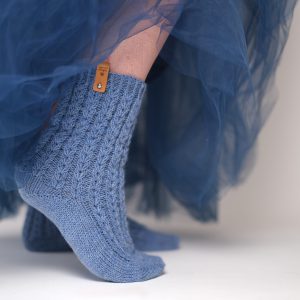
Choosing the right pattern for you
Sometimes choosing the right pattern can be a challenge in itself. Here are some tips for choosing a pattern that is perfect for you. Pick something that inspires you. If you love the look and experience of knitting your pattern, that will be so much more motivating for you to finish. Select a pattern that is appropriate for your skill level. It is great to choose a design with some new elements. This helps you learn new skills. Because socks are a smaller project, you can challenge yourself to learn a new skill without it bogging you down too much. However, if there are too many challenging elements, this could end up being discouraging. Finally, I recommend picking a design that suits your style (or the style of the person you are knitting for). You don’t want to make some that you don’t end up wearing. If you choose something that fits well with your closet, you’ll get maximum use out of all your hard work.
Now that you have an understanding of the steps needed to make a sock, and some of the most common design elements, it’s time to get started with knitting some socks. Hopefully the patterns we showcased here have inspired you to get started on knitting some socks of your own. You can never have too many socks!

